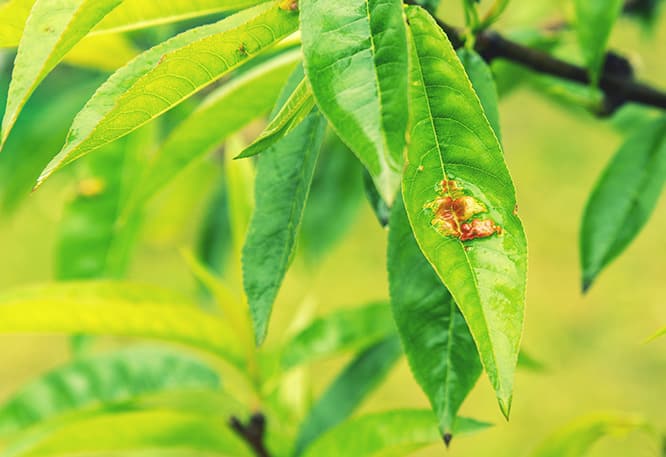Are the trees in your backyard safe from problems and diseases? No, no matter what you do. Insects, animals, the wind, water, and even people can carry the disease from tree to tree. Environmental impactors, construction, drought, and earthquakes can all change the health of your trees overnight as well. Unfortunately, there really isn’t anything you can do to stop any of that from happening.
What you can do, however, is learn the signs and symptoms of the most common diseases that trees can get in your area. This will help you to identify problem areas and catch diseases early, when it is still possible for you to do something about it.
Check out these symptoms of common tree diseases:

- Leaf Spots
Probably the most common disease found on trees in Missouri is leaf spots. This is a simple fungal infection that doesn’t actually do much damage to your tree. This is because there is still plenty of leaf real estate for carrying out the basic functions of a tree, including photosynthesis, per the University of Minnesota.
The only time you really need to worry about leaf spots is when there is severe defoliation. However, this typically doesn’t occur until later in the season and doesn’t come back the next year. UM also suggests that “Leaf spot diseases should be taken more seriously if they result in moderate to complete leaf loss two to four years in a row. Leaf loss during several consecutive growing seasons can result in reduced growth and increased susceptibility to opportunistic pests and pathogens.” - Root Rot
Root Rot is a tricky disease to catch because so much of it occurs under the ground. By the time we see physical symptoms of the disease, it is often too late to save it. Even worse, the tree can die extremely quickly without enough time for you to find it. That is why it is so important to contact a tree care professional – the roots and stump will stay poisonous and infect other trees.
The best way to prevent root rot is to keep your trees as healthy as possible. A healthy tree with enough nutrients and water getting to the tree will help to prevent root rot from taking over.
According to the Missouri Botanical Garden, ornamental trees are most likely to have root rot, but it is possible in all trees. - Fire Blight
Fire Blight can be one of the grossest diseases your tree will get if you don’t catch it quickly enough. In the early spring months, Fire Blight will make your trees start to turn yellow and cause blooms to die after only a few days. After a few weeks, your branches and leaves will look like they’ve been burnt.
Then the disgusting part happens.
Your tree will start to ooze a liquid as it tries to repair itself. The liquid is actually bacteria that is somewhat sticky and resembles sap, but that isn’t what it is. Once your tree starts to ooze that liquid, it is extremely contagious and can infect other trees in your neighborhood, according to the University of Georgia. - Apple Scab
If you have apple trees in your yard, you are probably used to seeing “scabs” or blemishes on your apples. However, there comes a time when they start to become a hindrance rather than just something annoying. If your apples seem strange from what you are used to, either they have more blemishes than usual, they are too small, or you don’t get as many flowers, you might have a severe case of Apple Scab.
According to Planet Natural, “Apple scab overwinters primarily in fallen leaves and in the soil. Disease development is favored by wet, cool weather that generally occurs in spring and early summer.”
It is important to get it under control because the disease will spread to all of your trees if you aren’t careful. - Iron Chlorosis
Some homeowners in Missouri have complained that their trees are dying quickly and without a lot of notice. Part of that could be because of highly alkaline soils, which are common in our area in particular. This is a disease that doesn’t have to be deadly, but by the time we catch it, there is sometimes too much damage. If your tree is suddenly weird or you have a seedling that isn’t taking, this could be the problem.
Correcting Iron Chlorosis is possible, but it isn’t easy to do. Trees that have been severely affected need the skills of a professional. The best thing to do is have your soil tested before you plant a tree so that you can avoid it altogether. The Missouri Botanical Garden suggests that you can “Improve the soil surface by mulching with 2–4 inches of organic materials such as leaf mulch or compost.”
Any of those diseases look familiar? If they do, there is still time to act and save your trees. You have to be proactive in calling a tree service company that can identify and treat problems on trees of all kinds. The team at Go Green Tree & Stump Removal can do that for you. Our workers have been completely trained on the most common Missouri tree diseases. Even better, we make efforts to treat your yard with the safest possible approaches.
Tree Disease Experts
Whether you just want an inspection so that you can sleep at night without having to worry about whether your tree has a disease or you know that you have a diseased tree, we can help you. Give us a call at (816) 520-4864 at your earliest convenience.



